by Smriti Daniel, Al Jazeera, January 12, 2016
Meet those clearing the large number of landmines left behind by the army and the Tamil Tigers after Sri Lanka’s war.
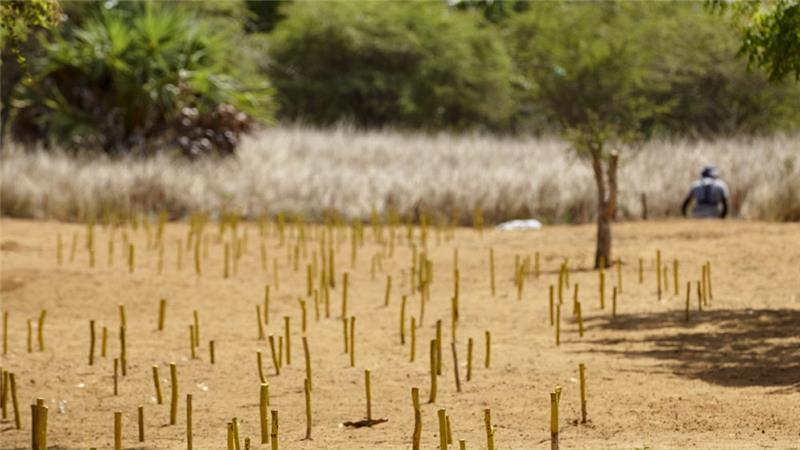
Sri Lanka is one of the most densely mined countries in the world. Since 2002 HALO has removed over 200,000 mines. [Devaka Seneviratne/Halo Trust Archives/Al Jazeera]
Muhamalai, Sri Lanka – Not so long ago Shanmukam Thankamuththu had 25 goats; now she has only five.
The other 20 have been sold, each animal bringing in 9,000 rupees, or around $60, depending on its size. “I sold one and used the money to build this wall. I sold another to dig the well,” she says, explaining how her goats paid for her house.
This sturdy but cramped single-room structure is occupied by the 56-year-old, her husband and the two youngest of their seven children, along with two dogs and a ginger kitten. Thankamuththu is one of hundreds of thousands of people internally displaced – many more than once – over the course of Sri Lanka’s 26-year civil war.
Humble though their new residence might be, this time she is hoping that she will never have to leave.
Repeated losses have made a pragmatic woman out of her, but the thought of her first home of 17 years, close by but currently inaccessible, still fills Thankamuththu with emotion. “If I talk about it I will cry,” she says.
Her eyes fill as she remembers that first displacement back in 2000 – after three days of shelling had rendered their bunker ineffective, they finally fled on foot. They locked everything they could not carry in a room, but had to leave a water pump that had cost them $500 unprotected, and a fine chilli garden, whose remembered largesse is still a source of pride.
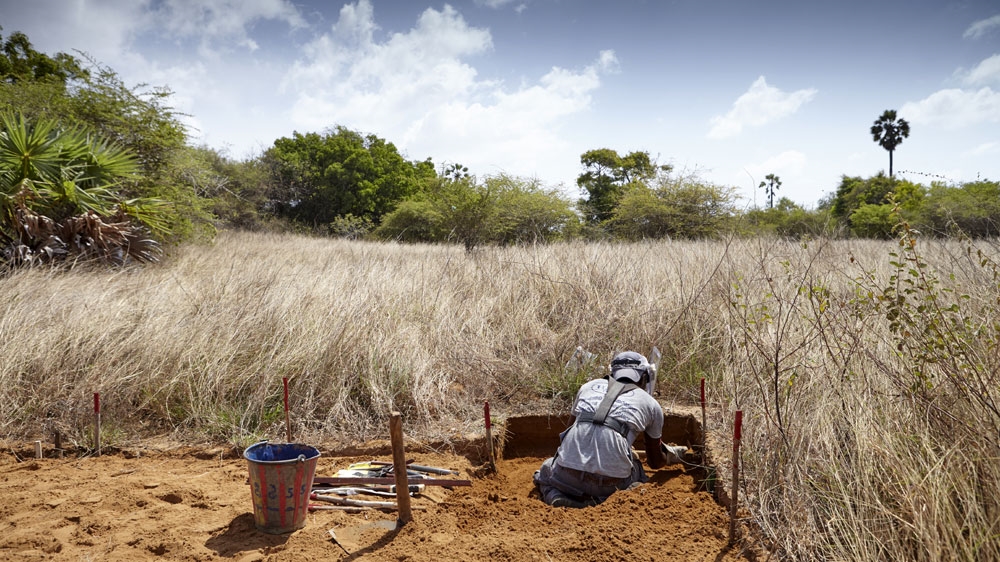
De-miners work in the baking heat to clear Sri Lanka’s largest minefield. [Devaka Seneviratne/Halo Trust Archives/Al Jazeera]
Minefields
Sprawling over 12 square kilometres, the minefield at Muhamalai in the northern district of Kilinochchi is unique, even in an area on intimate terms with mines.
The prosperous village, once associated primarily with coconut plantations, was ravaged by violent confrontations between the insurgent group, the Liberation Tigers of Tamil Eelam (LTTE) and the Sri Lankan Army (SLA). The Tamil Tigers, as the LTTE were also known, wanted to establish a homeland for the minority Hindu Tamil population, in a country where the majority are Sinhalese Buddhists.
In the years that followed the Tamil Tigers would be designated a terrorist organisation – notorious for pioneering suicide bombings, assassinating dozens of prominent leaders, both Tamil and Sinhalese, recruiting child soldiers and – crucial to Muhamalai’s eventual fate – producing their own range of mines.
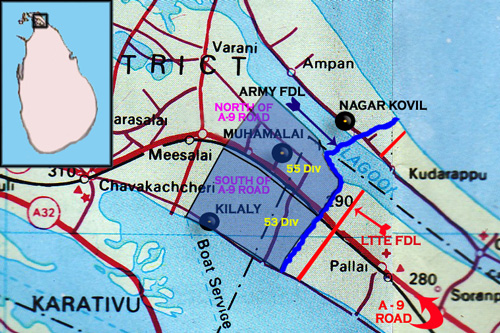
Defence.lk 2008
“From what I have seen here, the LTTE were among the most resourceful and disciplined rebel army that the modern world has seen. They had their own aircraft, they were building submarines. They had munitions factories and they waged a civil war for decades,” says Damian O’Brien, a programme manager for the international demining agency, the HALO Trust.
Particularly between 2000 and 2009, when the SLA finally defeated the LTTE, Nagar Kovil and Muhamalai would witness some of the most intense fighting of a long war.
The two sides laid out heavily fortified forward defence lines here. The minefields took the shape of a broad swath in Muhamalai, which narrowed as it crossed the neck of the Jaffna isthmus and then continued into the sandy soils of the former fishing village of Nagar Kovil.
The mine lines finally stopped at the Indian Ocean on the island’s east coast.
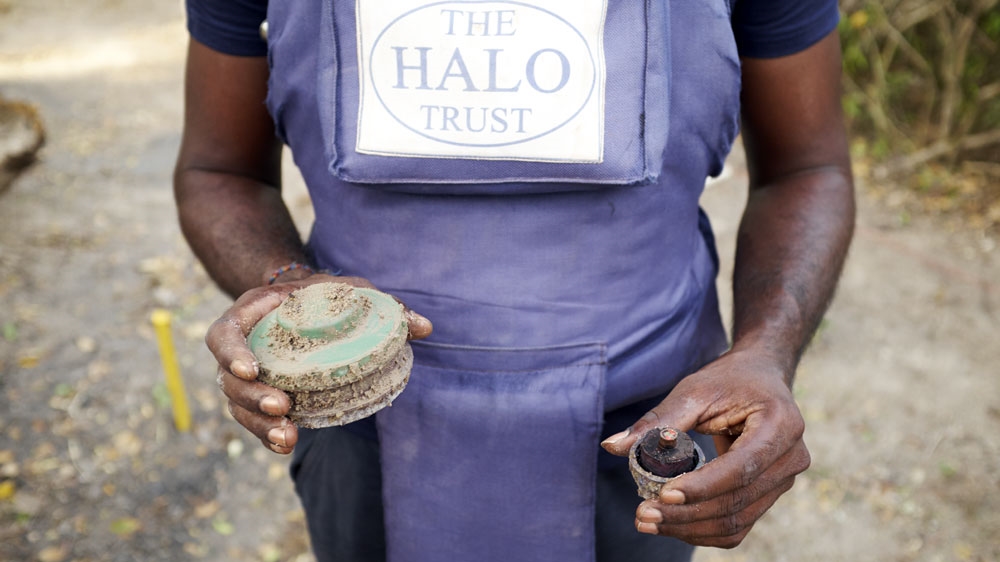
An LTTE Rangan mine with detonator unscrewed. An intact Rangan can be safely removed from the ground if it is not linked to other devices [Devaka Seneviratne/Halo Trust Archives/Al Jazeera]
Other explosives
There are also plenty of other forms of explosives, ammunition and unexploded ordinance (UXOs) littering this earth.
Rajudurai Sritharan, a senior survey officer with HALO, says that he still gets as many as 10 calls a day asking for help with such finds.
“They tell me when there is a suspect item,” he says. In fact, he already had one this morning from a school close to the border of Muhamalai.
The DASH de-mining agency’s estimates, based on data from the National Mine Action Centre, place the total number of mines in the country somewhere between 1.3 million and 1.5 million, of which more than 600,000 mines have reportedly been recovered.
According to the Landmine and Cluster Munitions monitor, described as the “bible for de-mining efforts”, the number of landmine casualties by the end of 2013 was some22,150, which included civilians, SLA soldiers and ex-LTTE combatants.
According to the latest figures from UNICEF, another 22 lives were claimed by mines in 2013, with 45 percent of all casualties that year occurring in Kilinochchi. In 2014, 16 people were killed, but by 2015 that number had dropped to six.
Years after the end of the war, this plethora of abandoned weaponry still renders lethal long stretches of land where people once lived and worked.

Each pin on the map marks the location of a minefield [Devaka Seneviratne/Halo Trust Archives/Al Jazeera]
Delvon Assistance for Social Harmony
Retired Brigadier Ananda Chandrasiri was closing in on 60 when he co-founded and began running Sri Lanka’s only national humanitarian de-mining organisation, the Delvon Assistance for Social Harmony, better known by the rather jaunty acronym of DASH.
A little less than a decade later, the end of Chandrasiri’s mission feels like it is in sight. He has seen his fair share of fighting over 36 years, including as a colonel attached to infantry brigades in Kilinochchi and Mannar and at the head of an army engineering brigade. Even in those intense, last years of the war, however, Chandrasiri was more interested in taking mines out of the ground than putting them in.
He carries around in his head a virtual encyclopaedia of the mines deployed during the war. The army mines were imported from places such as Pakistan and China, but the LTTE’s explosives, in retrospect often surprisingly superior products, were made locally.
The first anti-personnel mine deployed by the LTTE was the Jony in the 1980s, Chandrasiri explains. The simple wooden box was packed with 90g of TNT.
Then in the 1990s, the Rangan 99 debuted with an explosive punch of 120g of TNT. “As far as quality was concerned, they could stay live for longer than conventional [imported] mines could,” says Chandrasiri, “maybe even 20 years or more.”
“At various stages during the war, the LTTE used a lot of improvised devices,” O’Brien says. “The major munitions factories that we have come across were churning out thousands and thousands of landmines and mortars. There are also attempts at more complex weapons like the LTTE aircraft bomb.”
Exactly how many mines were laid down, no one is quite certain. “We say they [the LTTE] didn’t give us any records,” says Chandrasiri, “but to be fair, I don’t think they had any to give.”
To unravel the orderly pattern of an SLA minefield, one had only to discover the first mine.
The LTTE on the other hand were unpredictable – planting a circle of explosives around a well where soldiers might stop for water or in the gardens of homes they abandoned to the advancing Sri Lankan army. Mines have been found in pots of curd and plastic cricket bats.
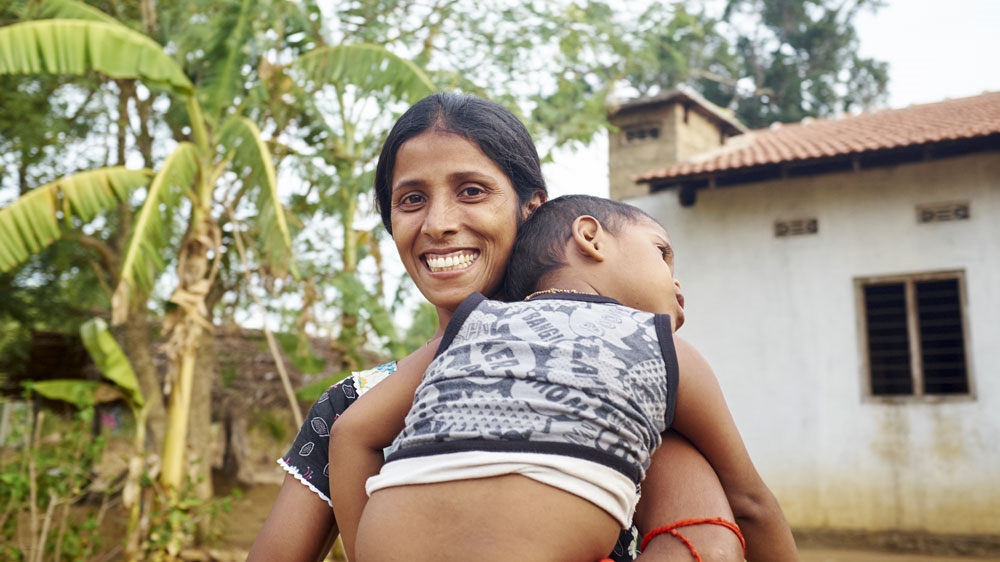
Sasi’s husband was killed in the war. She lost a leg to a landmine and when she returned after years of displacement she found her land was mined. Now it has been cleared by HALO.[Devaka Seneviratne/Halo Trust Archives/Al Jazeera]
Protective de-mining equipment
One never knows what might be found in a former war zone. In 2015, de-miners with the HALO Trust found 403 grenades in one day, another team uncovered a store of 580 mines, five improvised explosive devices and three Bangalore torpedoes, while yet another team brought in 942 detonators and 9,340 bullets in a single haul. They have found bodies and bunkers.
However, the work, more often than not, is without surprises, and entails painstakingly unearthing one mine at a time.
Typically, manual de-mining is the slow but reliable option.
Today, Vimalasweran Gunamala is loosening the soil around a buried mine. Lean but strong, she plies her spade in a square of excavated earth .
The boundary line beginning close to her elbow is marked by a painted red stick and a sudden sprout of shrubs. Another mine sits literally right by that edge – this one, in the open. It may have been shifted by rains, but it looks simply like someone bent down, casually deposited his lethal burden and walked away.
When a break is called, Gunamala lifts off her heavy visor. In northern Sri Lanka, where temperatures have been known to reach 28 degrees Celsius, the thick pants, long-sleeved shirts, gloves, tall boots and padded vest of the mandatory uniform must leave her and the others cooking in their own sweat, but the de-miner does not complain.
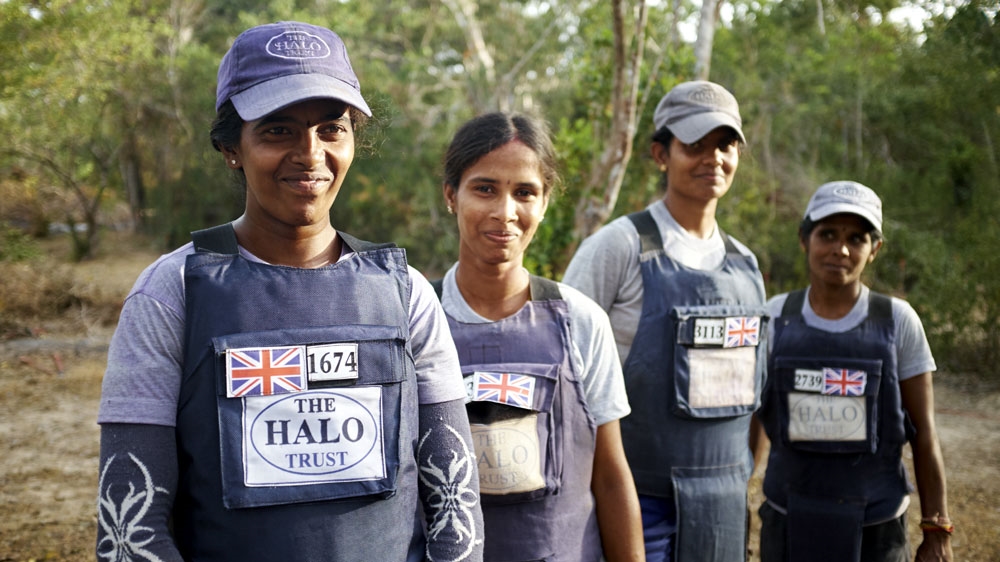
Fifty percent of HALO’s de-miners in Sri Lanka are women. Many are the sole earner in their household [Devaka Seneviratne/Halo Trust Archives/Al Jazeera]
Female de-miners
Gunamala is a female head of household, one of an estimated 1.2 million in Sri Lanka, according to data from 2013 from the Department of Census and Statistics. Her husband, who has suffered from chronic liver disease for 13 years, is bedridden. They have three children, named with pleasing symmetry – Kajendran, Kanjaruban and Kajendini. Again and again, Gunamala says, “I just want to take care of them.”
O’Brien has championed female de-miners in this posting, and notes that unlike, say, in Afghanistan, it is actually possible to ensure that in Sri Lanka 50 percent of his de-miners are female.
At HALO, women are finding their way into higher management, and they now have three section commanders who oversee multiple teams. Speaking of these promotions, O’Brien says that he wanted “women to have opportunities for progression – because that’s what we offer the men”.
For her part, Gunamala appreciates the reliable pay cheque that comes with this job, but money is still tight and life hard.
She is woken every day at 2am to cook and clean, and returns in the afternoon to do more of the same. Things were not like this for her mother’s generation, she says. Then one could focus on housework and raising children, “but these days women are expected to do everything”.
In her office, P Jeyarani, the divisional secretary for the Pachchilaipalli area in Kilinochchi, acknowledges the issues female heads of households face. For many, each day is a constant struggle for economic stability and personal security.
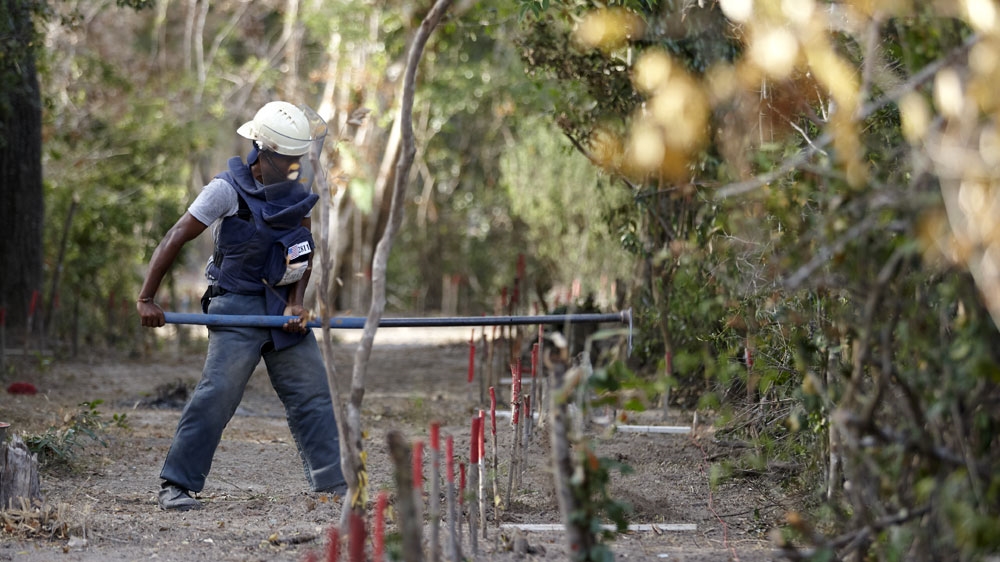
New dual sensor mine detectors give off different signals for harmless bits of metal and mines. Here, a de-miner conducts rapid excavation of a harmless signal [Devaka Seneviratne/Halo Trust Archives/Al Jazeera]
Returnees
In the meantime, other returnees with claims to large estates are planning to regrow their ancestral coconut plantations.
In an area experiencing unpredictable weather and labour shortages, even such homecomings are not without their problems.
Suresh Kumar drives some 60km to meet and explain how the $374,000 he has invested in his coconut plantation will take several years to turn a profit. In the meantime, he has plans for a poultry farm and hopes the government will assist him.
But the authorities are juggling many other priorities.
Jeyarani’s records list 257 families who have already registered their claims to mined lands in her district. That number is likely to increase with people returning from abroad.
Most families have deeds, she says. “Their problem is actually locating the land sometimes, because some have been displaced for 20 years.”
Determined to ensure a smooth transition, the divisional secretary sees her real challenge as the recovery of a traumatised populace. “We can easily give the housing and infrastructure, but mentally … that recovery will take time.”
De-mining technology
As a requirement of his own training, Damian O’Brien worked as a de-miner, doing his stint in Somaliland. The Englishman is now based in the HALO Trust’s Kilinochchi office, where he is a programme manager.
Working in a former warzone presents him with its own unique challenges.
“There are lots of workplace issues that clearly come from the fact that these people have been traumatised during the war: they have spent time in half-way camps, they’ve got difficult home lives and live in deprived areas,” he says.
It is partly why he plans to pause this week to celebrate the organisation’s achievement of pulling 200,000 mines out of the ground. “I don’t think the de-miners get enough recognition for the work they do.”
HALO’s Sri Lanka programme is pioneering in more ways than one, however, particularly in terms of the technology being deployed.
HALO is already using Handheld Standoff Mine Detection Systems, which help to clearly differentiate between mines and metal debris and have improved clearance rates in Sri Lanka by up to 40 percent.
Other innovations include using armoured flail machines and BeachTech sand filtering machines which come in handy on the right terrain and allow for rapid clearance.
They have also begun using Skybox, a satellite imagery service provided free of charge by Google to NGOs. “It’s been particularly useful when looking at post-clearance land use to show donors the impact their support has had,” says O’Brien.
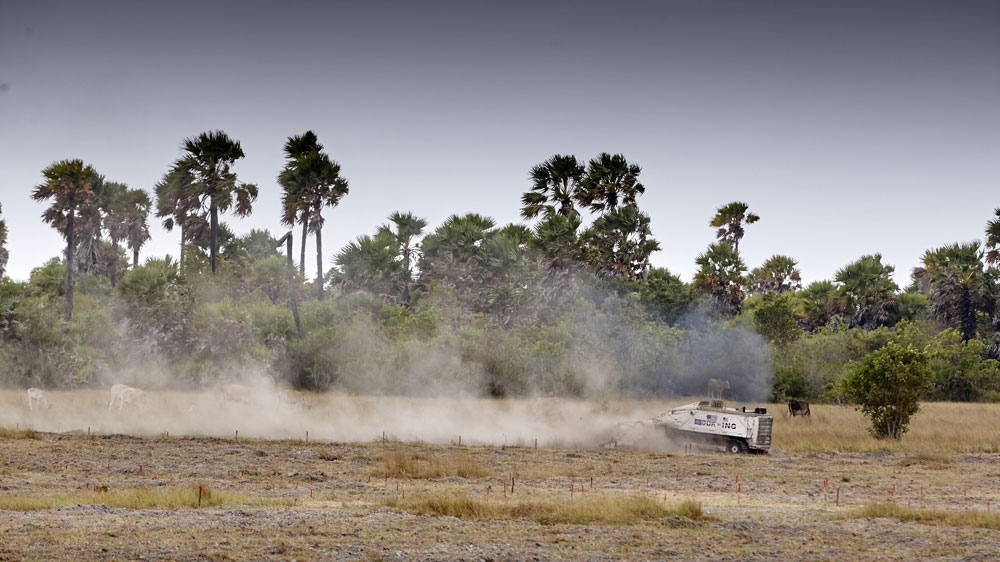
lail machines are used in low-threat areas to determine the presence of mines. If evidence of mines is found, full clearance will take place [Devaka Seneviratne/Halo Trust Archives/Al Jazeera]
Obstacles to de-mining
However, HALO, traditionally one of the biggest operators in the country, has seen the number of its teams shrink – one indication that work in these areas has not always progressed smoothly.
Under former President Mahinda Rajapakse’s government, in a political context of suspicion and hostility directed at NGOs, all international operators were told that they would have to leave the country. Traditionally, de-mining in Sri Lanka has been supported by funds from the European Union, Japan, Australia, the US and Britain.
Donors balked, forcing HALO to lay off some 700 people, while other agencies closed down shop.
However, a new government elected into power in 2015 and headed by President Maithripala Sirisena lifted the directive and suggested an alternate deadline – that Sri Lanka be declared mine-impact free by 2020. In December, MM Nayeemudeen, the additional secretary of the ministry of resettlement, announced at a Meeting of States Parties to the International Mine Ban Treaty that Sri Lanka was seriously considering becoming a signatory – a move that could unlock more funding and speed up the process of de-mining considerably.
INTERACTIVE FEATURE: Sri Lanka Civil War
The task of de-mining this island nation is not as daunting as it appears.
For a start, the actual remaining area requiring clearance will be less than the figures listed, as identifying mine lines will help agencies to zero in on narrower stretches of contaminated lands. Yet, DASH’s Chandrasiri still pauses when asked if the government’s ambitions are realistic.
Speaking of the inevitability of some explosives remaining undetected in remote forests or deeply buried in the soil, he says: “We might not be able to take every single mine out of the ground, but the important thing is that people will be able to go on with their lives.
“They will no longer need to be afraid.”